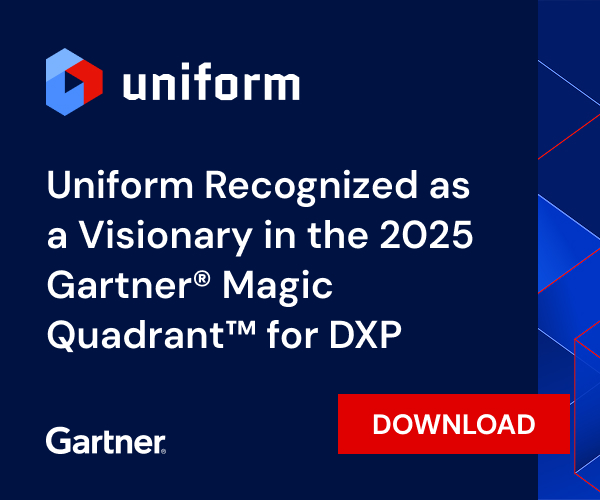Uniform is the
original composable digital experience platform (DXP) that eliminates the friction between marketing ambition and technical execution. Unlike traditional platforms that force teams to choose between flexibility and usability, Uniform enables marketers to create and optimize digital experiences independently while empowering developers to build with their preferred technologies.
Most organizations struggle with a familiar problem: marketing teams have ideas that require weeks of developer implementation, while development teams spend time on routine campaign tasks instead of building innovative platform capabilities.
Uniform solves this by providing a
visual workspace where both teams can excel at what they do best.
Traditional digital experience platforms create dependency chains that slow all teams down:
- Marketing teams submit tickets for content updates
- Developers context-switch between strategic projects and campaign implementation
- A/B testing requires sprint planning
- Personalization becomes a development project instead of a marketing experiment
Headless content management systems promised to solve this by separating content from presentation, but they created new problems:
- Technical teams handle most campaign implementations
- Non-technical users struggle with API-driven workflows
- Integration complexity multiplies with each tool added to the stack
Uniform eliminates these bottlenecks through
digital experience composition, allowing marketers to create sophisticated experiences using content from multiple sources without writing code or waiting for developer availability.
Uniform operates as the orchestration layer that connects existing technology investments while providing visual tools for experience creation. Teams continue working with the stack–content management, commerce, customer data—all the existing systems they prefer, while gaining a unified workspace for experience composition.
Marketing teams use the Visual Workspace to compose experiences by arranging components,
personalizing content, and launching
A/B tests without technical intervention. They can preview experiences across devices, publish instantly, and optimize based on real performance data.
Developers establish the foundation by creating
reusable components and integration
patterns once, allowing marketing teams to leverage them as building blocks across multiple campaigns and channels. This approach ensures consistency and performance while enabling marketing independence.
The platform handles edge optimization without manual intervention, so personalized experiences load instantly without the performance penalties that accompany dynamic content. Built-in
AI agents are available 24/7 to identify optimization opportunities and help improve search rankings.
Marketing autonomy: Teams create, test, and optimize experiences without developer dependencies. Campaign launches happen in hours instead of weeks because approval bottlenecks disappear.
Composable architecture: Easy connect well-known systyems through
pre-built integrations. Technology investments become more valuable, not obsolete.
Performance without compromise: Personalized experiences render at the edge with no flicker or slow load times. Page speed remains consistent whether serving one variation or hundreds.
Developer freedom: Build with React, Vue, Next.js, or any preferred framework. The platform adapts to technical choices versus than dictating them.
Incremental adoption: Integrate with existing legacy systems to allow for gradual modernization of the stack. No "rip and replace" migrations required.
A
major insurance provider migrated from their legacy platform and gained 30-point Lighthouse performance improvements while reducing page translation time from weeks to one week. As their development manager explained: "We needed to switch from Sitecore, and it was clear that Uniform was the right solution."
Technical teams appreciate Uniform because it reduces their support burden without compromising architectural control. They are able to focus on building platform capabilities instead of troubleshooting campaign launches.
Organizations with complex technology ecosystems use Uniform to unify disparate systems without expensive migrations. Teams can keep their beloved CMS while adding Uniform's visual experience composition capabilities.
A fintech company saw a 15% registration increase and ran significantly more experiments after adopting Uniform's optimization capabilities. The platform connects existing tools with modern personalization and optimization features, creating hybrid architectures that enhance current investments.
Uniform does not replace existing technology investments—it makes them work better together. If teams love their CMS for content management or their commerce platform for transactions, Uniform will connect these and all systems through a unified visual workspace where marketing teams can orchestrate experiences that blends content and data from each.
Traditional CMS-based DXPs require technical expertise and long implementation cycles. While powerful, they keep marketing teams dependent on development resources for routine tasks.
Uniform creates the connection layer that transforms individual systems into a cohesive experience platform. Existing investments become more valuable, not obsolete.
- Marketing velocity increases as teams gain direct control over experience creation
- Development productivity improves as routine support requests decrease
Organizations ready to eliminate the trade-offs between marketing speed and technical flexibility discover that Uniform transforms team dynamics and business outcomes.
When marketing and development teams can each excel at their core strengths, the entire organization moves faster and delivers better customer experiences.
Ready to see this for yourself?
Request a demo to experience how Uniform eliminates friction in marketing development.






.png&w=1080&q=90)
.png&w=1080&q=90)
.png&w=1080&q=90)